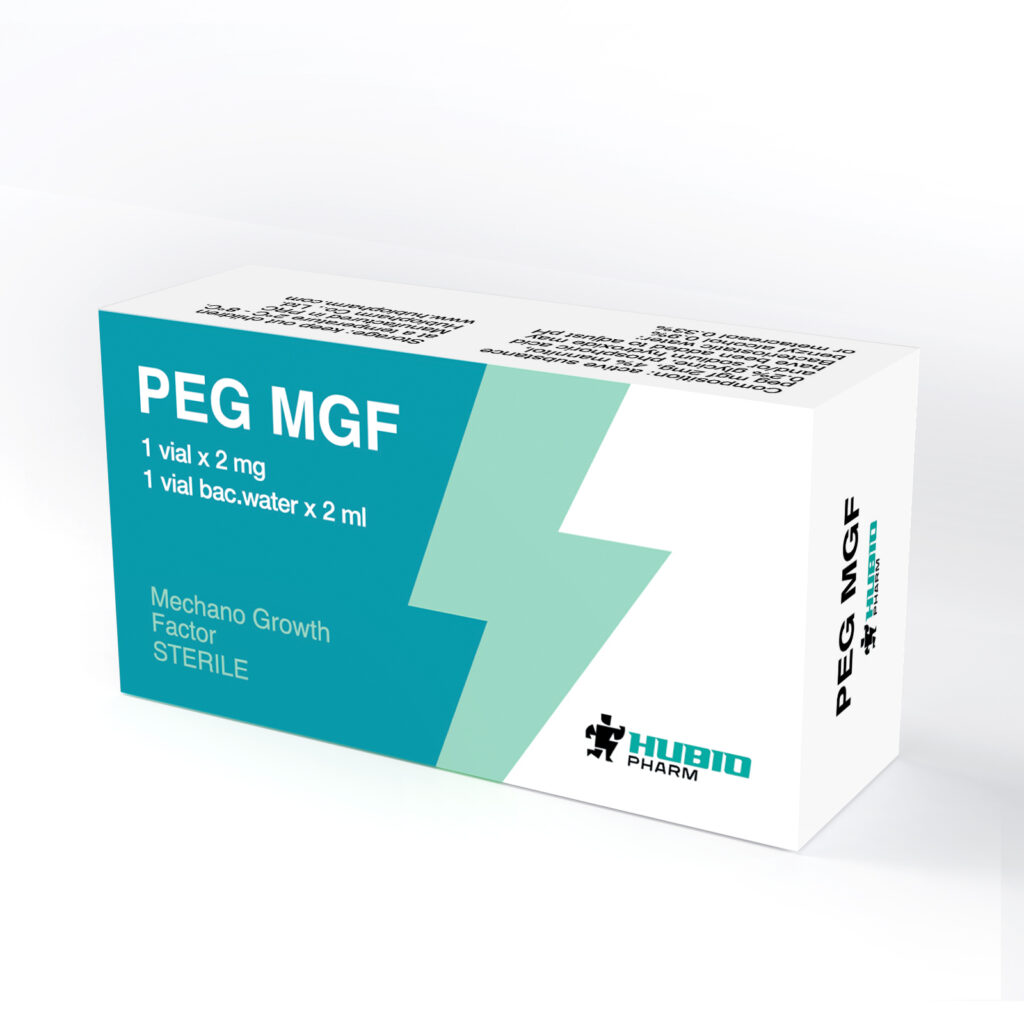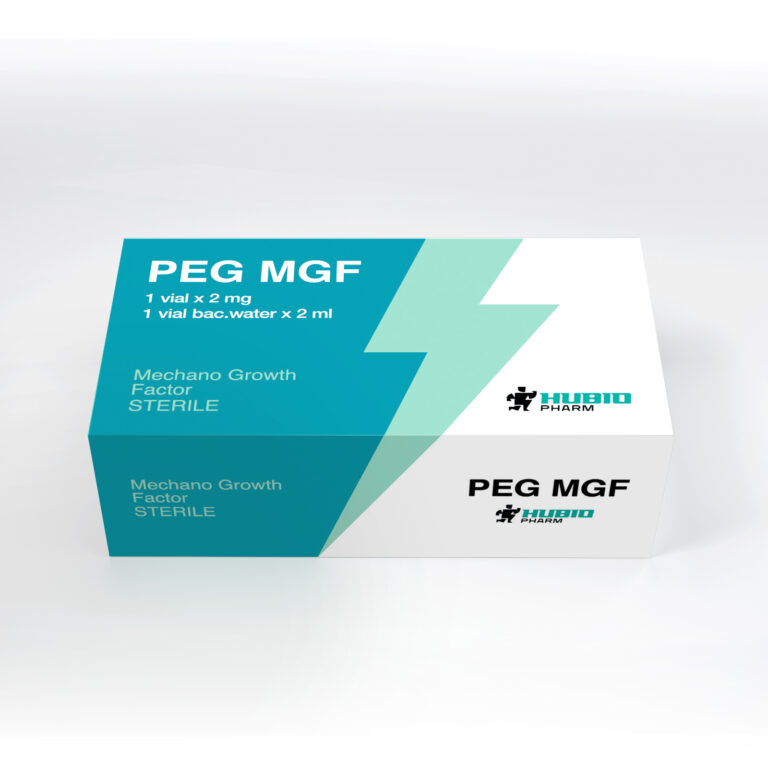- Introduction: PEG-MGF and Modern Muscle Research
- What Is PEG-MGF?
- Mechanism of Action: How PEG-MGF Supports Muscle Repair
- PEG-MGF in Laboratory Research
- PEG-MGF vs IGF-1 LR3: Differences and Complementary Effects
- Other Popular Research Peptides in Muscle Studies
- Applications of PEG-MGF in Therapeutic Research
- Legal and Safety Considerations
- Advantages of PEG-MGF in Muscle Research
- Practical Guidelines for Researchers
- Conclusion
- FAQ
Introduction: PEG-MGF and Modern Muscle Research
The field of peptide research has grown exponentially in recent years, providing scientists with powerful tools to study muscle repair, regeneration, and growth mechanisms. Among these, PEG-MGF (Pegylated Mechano Growth Factor) has emerged as one of the most promising compounds for laboratory research due to its unique ability to stimulate localized muscle repair while remaining stable for longer periods.
PEG-MGF is a synthetic, pegylated form of MGF, a splice variant of IGF-1 (Insulin-like Growth Factor 1), naturally produced in muscle tissues in response to mechanical stress or injury. By increasing the half-life and bioavailability of MGF, PEG-MGF allows researchers to study sustained regenerative effects in vitro and in animal models.
Note: PEG-MGF is strictly for research use only. It is not intended for human consumption, therapeutic use, or as a dietary supplement. It has not been evaluated by the FDA.
What Is PEG-MGF?
PEG-MGF is a modified peptide designed for enhanced stability in laboratory studies. MGF itself is a naturally occurring peptide released in response to mechanical overload or injury, signaling the body to initiate muscle repair and regeneration.
However, native MGF degrades rapidly, limiting its usefulness in controlled research. By attaching a polyethylene glycol (PEG) chain, scientists created PEG-MGF, a compound with longer half-life and improved biological activity, ideal for experimental protocols requiring prolonged exposure.
PEG-MGF has become widely studied in the United States for:
- Muscle cell proliferation
- Satellite cell activation
- Tissue regeneration and repair
- Studying anabolic pathways post-injury
Mechanism of Action: How PEG-MGF Supports Muscle Repair
PEG-MGF primarily acts by activating satellite cells, which are muscle stem cells responsible for regenerating damaged fibers. Activation of these cells leads to:
- Enhanced myoblast proliferation
- Accelerated muscle fiber repair
- Increased protein synthesis
- Reduction of inflammatory markers in damaged tissue
The pegylation extends the half-life from minutes to several hours, providing a sustained anabolic signal for in vitro or preclinical studies. Researchers often compare the efficacy of PEG-MGF with IGF-1 LR3, which has a longer systemic effect but is less localized.

PEG-MGF in Laboratory Research
Laboratory studies have explored PEG-MGF in multiple research contexts:
- Cell culture models: Myoblasts treated with PEG-MGF show enhanced differentiation and faster fusion into multinucleated fibers.
- Muscle injury studies: Animal models of induced muscle trauma demonstrate accelerated recovery with PEG-MGF administration.
- Inflammation and oxidative stress research: PEG-MGF appears to reduce pro-inflammatory cytokine activity, improving cellular survival post-injury.
These studies make PEG-MGF a key peptide for investigating mechanisms of muscle regeneration.
PEG-MGF vs IGF-1 LR3: Differences and Complementary Effects
Both PEG-MGF and IGF-1 LR3 are derivatives of the IGF-1 family, but they differ in mechanism and application.
| Feature | PEG-MGF | IGF-1 LR3 |
|---|---|---|
| Origin | Splice variant of IGF-1 | Modified IGF-1 analog |
| Half-Life | Extended via PEG | Long-acting systemic peptide |
| Function | Localized muscle repair | Systemic hypertrophy and anabolic signaling |
| Research Use | Post-injury recovery studies | Growth and metabolic pathway studies |
PEG-MGF is ideal for localized repair studies, while IGF-1 LR3 is better for systemic hypertrophy studies. Many research labs combine both peptides in controlled experiments to study acute vs. prolonged anabolic effects.
Other Popular Research Peptides in Muscle Studies

BPC-157
Known as the Body Protection Compound, BPC-157 is widely studied for its ability to promote tendon and ligament healing, angiogenesis, and soft tissue recovery. It is often paired with PEG-MGF in laboratory studies to evaluate synergistic repair effects.
TB-500
TB-500 (Thymosin Beta-4) enhances cell migration, tissue regeneration, and flexibility. In research settings, it is frequently combined with PEG-MGF to investigate enhanced recovery after muscle injury.
IGF-1 LR3
Long-acting IGF-1 analog studied for cell proliferation, anabolic signaling, and hypertrophy. Comparative studies with PEG-MGF help scientists differentiate local repair effects from systemic growth.
Applications of PEG-MGF in Therapeutic Research
PEG-MGF is primarily explored in muscle injury and regenerative medicine models, including:
- Acute muscle trauma: Accelerates repair and reduces inflammatory markers.
- Angiogenesis research: Stimulates blood vessel formation in damaged tissue.
- Satellite cell proliferation: Improves recovery efficiency in in vitro myoblast cultures.
- Combined peptide therapy studies: PEG-MGF is tested alongside BPC-157, TB-500, and IGF-1 LR3 for multi-pathway regenerative research.
While these are research models only, they provide valuable insights into future therapeutic applications in muscle recovery and sports science.
Legal and Safety Considerations
⚠️ PEG-MGF is for research use only. It is not a drug, food, or dietary supplement and has not been evaluated by the FDA. Misuse or human administration is strictly prohibited in the United States.
Laboratories working with PEG-MGF must:
- Maintain proper storage conditions (refrigeration for reconstituted peptides)
- Use safety protocols for handling lyophilized powders
- Follow federal research regulations for peptide use
Advantages of PEG-MGF in Muscle Research
PEG-MGF offers several benefits for research purposes:
- Longer half-life due to pegylation
- Targeted action on damaged muscle tissue
- Improved reproducibility in experimental studies
- Synergistic potential when combined with other peptides (BPC-157, TB-500, IGF-1 LR3)
- Reduction in inflammatory response, aiding tissue regeneration
Compared to systemic GH studies, PEG-MGF provides more localized, consistent, and measurable effects in research environments.
Practical Guidelines for Researchers
For laboratories studying PEG-MGF:
- Store lyophilized PEG-MGF at -20°C; reconstituted solution may require refrigeration.
- Follow sterile techniques during reconstitution and application.
- Consider time-course studies due to extended half-life.
- Combine with other regenerative peptides in controlled comparative research for maximum insight.
Conclusion
PEG-MGF represents a next-generation peptide for studying muscle repair and regeneration. Its pegylated structure allows for longer-lasting activity, making it ideal for:
- Satellite cell activation studies
- Tissue regeneration research
- Comparative analyses with IGF-1 LR3, BPC-157, and TB-500
As peptide science evolves, PEG-MGF will continue to provide researchers with reliable, targeted insights into muscle recovery mechanisms.
For laboratory studies, consider:
FAQ
Q1: What is PEG-MGF?
A1: PEG-MGF is a pegylated form of Mechano Growth Factor, a splice variant of IGF-1, designed for muscle repair and regeneration research.
Q2: How is PEG-MGF different from IGF-1 LR3?
A2: PEG-MGF targets localized muscle repair, while IGF-1 LR3 promotes systemic muscle growth.
Q3: Can PEG-MGF be used clinically?
A3: No. PEG-MGF is strictly research use only and is not approved for human or veterinary use.
Q4: Which peptides are commonly studied with PEG-MGF?
A4: Researchers often study PEG-MGF alongside BPC-157, TB-500, and IGF-1 LR3 to evaluate combined regenerative effects.




